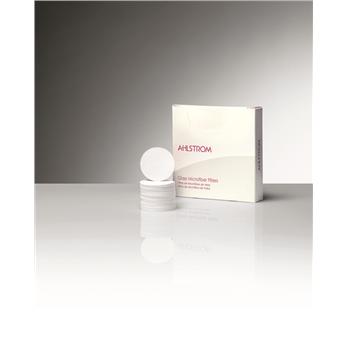Glass Microfiber Filter Paper, Ahlstrom 151, 32.00cm, Pack of 100

|
|
Details:
Additional Info Ahlstrom offers a full range of glass microfiber filters manufactured from 100% pure borosilicate glass. Because of their intrinsic properties, glass microfiber filters have wide applications in many areas of laboratory analysis, especially when fine filtration and high loading capacity is required. Applications for Ahlstrom glass microfiber filters include environmental analysis for water, wastewater, testing of soils, air pollution and monitoring, research and process biochemistry, and gravimetric analysis involving ignition of samples. Ahlstrom glass microfiber filters are also found in the filtration of hot gases and liquids, and in pre-filtration.Laboratory analysis100% pure borosilicate glassRapid flow rateFine particle retention 0.7µm – 3.1 µmHigh loading capacityChemical and thermal resistance (up to 500°C)Long shelf lifeBrilliant white color reflecting more than 96% of visible lightCustom cutStandard Glass Microfiber FiltersStandard glass microfiber filters contain no binders or other additives that may cause interference to sensitive enzymatic or other chemical reactions. The unique characteristics of glass microfiber filters make its use particularly advantageous to laboratory filtration by enabling fast filtration of large volumes and difficult solutions without premature clogging.Ahlstrom 151: 0.7µm – Slow SpeedThis high performance grade is designed to retain extremely fine particles down to 0.7 µm. Ahlstrom 151 has retention comparable to membrane filter while providing higher flow and loading capacity. Ahlstrom 151 is recommended for filtering fine precipitated proteins. In the filtration of nucleic acids and difficult biochemical solutions, Ahlstrom 151 is used in combination with Ahlstrom 141 as a highly efficient protective and retentive pre-filter to extend the loading capacity of membrane filters. Grade 151 is recommended for use in TCLP procedure as described in test methods for evaluating solid wastes, EPA method 1311.Environmental Laboratory Applications:40CFR SW-846 Method 1311 – Toxicity Characteristic Leaching Procedure (TCLP), SludgeThe propensity of sludge to leach potentially hazardous material into the ground water is analyzed with this method. Grade 151 meets the specified retention and chemical inertness requirements.Mining Laboratory Applications:40CFR SW-846 Method 1311-Toxicity Characteristic Leaching Procedure (TCLP), SludgeThe propensity of sludge to leach potentially hazardous material into the ground water is analyzed with this method. Grade 151 meets the specified retention and chemical inertness requirements.Ahlstrom Environmental Technical BulletinAhlstrom Grade 151 TDS
Additional Information
| SKU | 5102949 |
|---|---|
| UOM | Pack of 100 |
| UNSPSC | 41104929 |
| Manufacturer Part Number | 1510-3200 |
